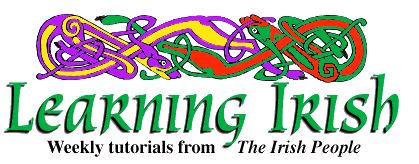
Irish Lesson 22
|
In this issue, we rerun the full pronunciation guide and study method, for the purpose of review and for those readers who have joined recently and need this information. PRONUNCIATION Americans studying Irish have always learned pronunciation from either an Irish speaker or from one of several recordings accompanying textbooks. Because we will not be able to teach pronunciation in these ways, we will give you a simple pronunciation-guide system and then extra instructions from time to time. If you have the chance to listen to a native speaker, however, do so. There are differences in regional pronunciation in Irish, as in other languages, but if the speaker talks slowly and clearly, you should have little trouble in understanding the words you know. The pronunciation given in the guide for this lesson series is not based exclusively on any one region of Ireland. Where the differences are significant, we will give you some of the other pronunciations and usages, to make it easier to talk with all speakers. STUDY METHOD
In the conversation exercises, you will see words and phrases that will seem difficult at first. Memorize them, and don't worry about the grammar. It will be explained later. PRONUNCIATION-GUIDE SYSTEM Most of the symbols are letters and letter groups for sounds common in familiar English words. If you pronounce them in that way for the first few lessons, you will be close enough for a beginning. We will gradually correct you and improve your pronunciation as you advance, so that you will soon have a genuine Irish pronunciation. For most consonants, such as b, d, f, g, h, l, m, n, p, r, s and t, we will use the letters themselves as pronunciation symbols. In the lessons, you will get instructions on how to pronounce these sounds in the Irish way. Nearly all these consonants have two sounds in Irish, depending on what vowels are next to them. (English "c" and "g" also have this characteristic. Notice how you statrt to pronounce "king" and "coat", and then "give" and "go".) The vowel symbols may need some explanation, so here are the symbols and description of their pronunciation: Symbols and pronunciations: (ah) as in English "ah-hah" (a) as in English "at" (aw*) as in English "tot", but held for a longer time (ay*) as Irish pronounce English "say", without a trace of (ee) sound at the end (e) as in English "let" (ee) as in English "mean" (i) as in English "pin" (eye) as in English "eye" (oh) as in English "toe", but without the trace of (oo) sound at the end (oo) as in English "food" (uh) as in English "run" (u) as in English "put" (ou) as in English "shout" We will capitalize the letters in the accented part of the word or phrase. We will use asterisks, as in some symbols above, to indicate a sound fairly different from usual English sounds. Remember, too, that many Irish sounds are not exactly like their English counterparts. Some English sounds, such as "z" and "th", are not in Irish.
Now try these English words as practice in using the pronunciation-guide system: (boht) (HAM-muhr) (kin) (KUH-stuhm-ayr-ee) (de-LIV-uh-ree) (giv) (trans-LAYT) (ad-MEYE-uhr) (ful-FIL) (fuhn-duh-MENT-uhl) (wohnt) (wawnt) (tawt) The actual English words for these are: boat, hammer, kin, customary, delivery, give, translate, admire, fulfill, fundamental, won't, want, taught. These sounds are not always exact, as you can see, but are close enough to be understood. (c) 1997 The Irish People. May be reprinted with credit. |